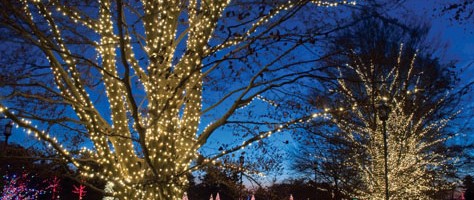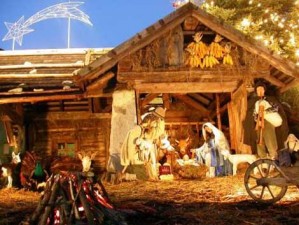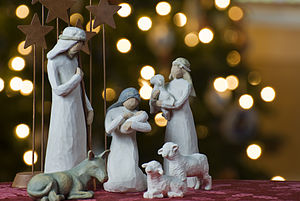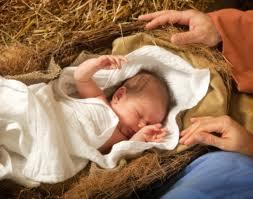Thoughts of Christmas…

When you hear the word Christmas, what is the first thing that pops into your mind?
In America, many of us think about twinkle lights; merry Christmas wreaths; or the smell of incense burning while candle light flickers onto lofty wooden beams or high stone arches laid together by pious ancestors long dead but still remembered….
Perhaps your thoughts are of friends and family gathered, all standing round a large table laid with Christmas delicacies, longing for the end of the prayer, for to taste such sweet nectar that heralds the Christmas celebration.
For me, it is the Nativity that I remember best and the Christmas Creche in particular… maybe because this year I lost ours and can’t find it anywhere. What is a Christmas Creche?
 Let me start with defining Nativity. It may be possible that you have not heard of Nativity or the Christmas Creche and do not know of what I speak. Many of us did not hear it told as children, but were late in years before it was fully revealed.
Let me start with defining Nativity. It may be possible that you have not heard of Nativity or the Christmas Creche and do not know of what I speak. Many of us did not hear it told as children, but were late in years before it was fully revealed.
According to Free Dictionary (online) by Fairfax, the Nativity “is a three-dimensional model of the scene described in the Bible at the birth of Jesus Christ in a stable at Bethlehem, with Mary and Joseph near a manger in which a model of the infant Christ child is lain, and usually including figures of animals, shepherds, and the three wise men; – also called a Nativity scene. The figures in the scene are typically made as individual statues or figurines. Smaller models are displayed in homes and other indoor locations during the Christmas season, and larger models, often life-size, may be displayed out of doors”.
The Christmas Crèche, unfortunately cannot be defined as easily and to truly explain, it’s story must be shared. Allow me a moment to share the story of how the Christmas Creche came about and why it is significant. It is an old story and is posted in its entirety from the original works of Rev. William Saunders, “St. Francis and the Christmas Creche.” Arlington Catholic Herald.
“The story of the origin of the Christmas Crèche rests with a very holy man, named St. Francis of Assisi.
In the year 1223, St. Francis, a deacon, was visiting the town of Grecio to celebrate Christmas. Grecio was a small town built on a mountainside overlooking a beautiful valley. The people had cultivated the fertile area with vineyards. St. Francis realized that the chapel of the Franciscan hermitage would be too small to hold the congregation for Midnight Mass. So he found a niche in the rock near the town square and set up the altar. However, this Midnight Mass would be very special, unlike any other Midnight Mass.
St. Bonaventure (d. 1274) in his Life of St. Francis of Assisi tells the story the best:
It happened in the third year before his death, that in order to excite the inhabitants of Grecio to commemorate the nativity of the Infant Jesus with great devotion, [St. Francis] determined to keep it with all possible solemnity; and lest he should be accused of lightness or novelty, he asked and obtained the permission of the sovereign Pontiff. Then he prepared a manger, and brought hay, and an ox and an ass to the place appointed. The brethren were summoned, the people ran together, the forest resounded with their voices, and that venerable night was made glorious by many and brilliant lights and sonorous psalms of praise. The man of God [St. Francis] stood before the manger, full of devotion and piety, bathed in tears and radiant with joy; the Holy Gospel was chanted by Francis, the Levite of Christ. Then he preached to the people around the nativity of the poor King; and being unable to utter His name for the tenderness of His love, He called Him the Babe of Bethlehem.  A certain valiant and veracious soldier, Master John of Grecio, who, for the love of Christ, had left the warfare of this world, and become a dear friend of this holy man, affirmed that he beheld an Infant marvelously beautiful, sleeping in the manger, Whom the blessed Father Francis embraced with both his arms, as if he would awake Him from sleep. This vision of the devout soldier is credible, not only by reason of the sanctity of him that saw it, but by reason of the miracles which afterwards confirmed its truth. For example of Francis, if it be considered by the world, is doubtless sufficient to excite all hearts which are negligent in the faith of Christ; and the hay of that manger, being preserved by the people, miraculously cured all diseases of cattle, and many other pestilences; God thus in all things glorifying His servant, and witnessing to the great efficacy of his holy prayers by manifest prodigies and miracles.
A certain valiant and veracious soldier, Master John of Grecio, who, for the love of Christ, had left the warfare of this world, and become a dear friend of this holy man, affirmed that he beheld an Infant marvelously beautiful, sleeping in the manger, Whom the blessed Father Francis embraced with both his arms, as if he would awake Him from sleep. This vision of the devout soldier is credible, not only by reason of the sanctity of him that saw it, but by reason of the miracles which afterwards confirmed its truth. For example of Francis, if it be considered by the world, is doubtless sufficient to excite all hearts which are negligent in the faith of Christ; and the hay of that manger, being preserved by the people, miraculously cured all diseases of cattle, and many other pestilences; God thus in all things glorifying His servant, and witnessing to the great efficacy of his holy prayers by manifest prodigies and miracles.
Although the story is long old, the message is clear for us. Our own Nativity scenes which rest under our Christmas trees are a visible reminder of that night when our Savior was born. May we never forget to see in our hearts the little Babe of Bethlehem, who came to save us from sin? We must never forget that the wood of the manger that held Him so securely would one day give way to the wood of the cross. May we too embrace Him with all of our love as did St. Francis”.
Who is this Babe of Bethlehem for whom St Francis could not name?  It is none other than our God, Isa al masih, Jesus the Messiah, God clothed in flesh (John 1: 14) who was miraculously born (Matthew 1 and Matthew 2), long foretold (Isaiah 9: 6) and in fullness He came (Galatians 4: 4; Ephesians 1: 9-23 Ephesians 3: 14-19; Colossians 1: 19-22; Colossians 2: 9-13).
It is none other than our God, Isa al masih, Jesus the Messiah, God clothed in flesh (John 1: 14) who was miraculously born (Matthew 1 and Matthew 2), long foretold (Isaiah 9: 6) and in fullness He came (Galatians 4: 4; Ephesians 1: 9-23 Ephesians 3: 14-19; Colossians 1: 19-22; Colossians 2: 9-13).
But it was also foretold that God in flesh, this Babe of Bethlehem should suffer (Acts 3: 18-19), betrayed and then crucified (Mark 12:28 to the end of the book). Why would He allow death to overtake Him? It was for love that God chose to die (John 15: 13; Romans 5: 18; 1 John 4: 10) and this love will be for always (Romans 8: 35-40).
Gods love demonstrated through Messiah, will never fail (Ephesians 2: 4-5). This love, the love prepared by God is mysterious and hard to understand. But we must remember it is holy love sent down to us from the throne of heaven and miraculously it awaits for you (1 Corinthians 2:9).

 2. Praying through the Arabian Peninsula
2. Praying through the Arabian Peninsula 3. 24/7 Prayer
3. 24/7 Prayer One Way Ministries
One Way Ministries Prayercast
Prayercast